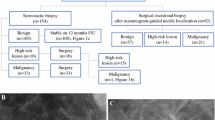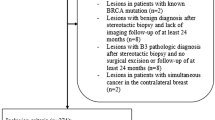Abstract
Objectives
To determine the malignancy rate overall and for specific BI-RADS descriptors in women ≥70 years who undergo stereotactic biopsy for calcifications.
Methods
We retrospectively reviewed 14,577 consecutive mammogram reports in 6839 women ≥70 years to collect 231 stereotactic biopsies of calcifications in 215 women. Cases with missing images or histopathology and calcifications associated with masses, distortion, or asymmetries were excluded. Three breast radiologists determined BI-RADS descriptors by majority. Histology, hormone receptor status, and lymph node status were correlated with BI-RADS descriptors.
Results
There were 131 (57 %) benign, 22 (10 %) atypia/lobular carcinomas in situ, 55 (24 %) ductal carcinomas in situ (DCIS), and 23 (10 %) invasive diagnoses. Twenty-seven (51 %) DCIS cases were high-grade. Five (22 %) invasive cases were high-grade, two (9 %) were triple-negative, and three (12 %) were node-positive. Malignancy was found in 49 % (50/103) of fine pleomorphic, 50 % (14/28) of fine linear, 25 % (10/40) of amorphous, 20 % (3/15) of round, 3 % (1/36) of coarse heterogeneous, and 0 % (0/9) of dystrophic calcifications.
Conclusions
Among women ≥70 years that underwent stereotactic biopsy for calcifications only, we observed a high rate of malignancy. Additionally, coarse heterogeneous calcifications may warrant a probable benign designation.
Key Points
• Cancer rates of biopsied calcifications in women ≥70 years are high
• Radiologists should not dismiss suspicious calcifications in older women
• Coarse heterogeneous calcifications may warrant a probable benign designation




Similar content being viewed by others
Abbreviations
- BI-RADS:
-
breast imaging reporting and data system
- DCIS:
-
ductal carcinoma in situ
- ER:
-
estrogen receptor
- HER2:
-
human epidermal growth factor receptor 2
- LCIS:
-
lobular carcinoma in situ
- PR:
-
progesterone receptor
- USPSTF:
-
United States Preventive Services Task Force
References
Hartman M, Drotman M, Arleo EK (2015) Annual screening mammography for breast cancer in women 75 years old or older: to screen or not to screen. AJR Am J Roentgenol 204:1132–1136
Galit W, Green MS, Lital KB (2007) Routine screening mammography in women older than 74 years: a review of the available data. Maturitas 57:109–119
Hurria A, Leung D, Trainor K, Borgen P, Norton L, Hudis C (2003) Factors influencing treatment patterns of breast cancer patients age 75 and older. Crit Rev Oncol Hematol 46:121–126
Walter LC, Schonberg MA (2014) Screening mammography in older women: a review. JAMA 311:1336–1347
Malmgren JA, Parikh J, Atwood MK, Kaplan HG (2014) Improved prognosis of women aged 75 and older with mammography-detected breast cancer. Radiology 273:686–694
Tabar L, Vitak B, Chen TH et al (2011) Swedish two-county trial: impact of mammographic screening on breast cancer mortality during 3 decades. Radiology 260:658–663
Kemeny MM, Peterson BL, Kornblith AB et al (2003) Barriers to clinical trial participation by older women with breast cancer. J Clin Oncol 21:2268–2275
Lee CH, Dershaw DD, Kopans D et al (2010) Breast cancer screening with imaging: recommendations from the Society of Breast Imaging and the ACR on the use of mammography, breast MRI, breast ultrasound, and other technologies for the detection of clinically occult breast cancer. J Am Coll Radiol 7:18–27
Smith-Bindman R, Kerlikowske K, Gebretsadik T, Newman J (2000) Is screening mammography effective in elderly women? Am J Med 108:112–119
Kerlikowske K, Salzmann P, Phillips KA, Cauley JA, Cummings SR (1999) Continuing screening mammography in women aged 70 to 79 years: impact on life expectancy and cost-effectiveness. JAMA 282:2156–2163
Breast cancer: screening. U.S. Preventive Services Task Force. http://www.uspreventiveservicestaskforce.org/Page/Topic/recommendation-summary/breast-cancer-screening. Accessed 13 May 2015
ACOG Practice Advisory on Breast Cancer Screening. American Congress of Obstetricians and Gynecologists. http://www.acog.org/About-ACOG/News-Room/Practice-Advisories/ACOG-Practice-Advisory-on-Breast-Cancer-Screening. Accessed 05 May 2015
Oeffinger KC, Fontham ET, Etzioni R et al (2015) Breast cancer screening for women at average risk: 2015 guideline update from the American Cancer Society. JAMA 314:1599–1614
Anderson WF, Pfeiffer RM, Dores GM, Sherman ME (2006) Comparison of age distribution patterns for different histopathologic types of breast carcinoma. Cancer Epidemiol Biomarkers Prev 15:1899–1905
Azim HA Jr, Partridge AH (2014) Biology of breast cancer in young women. Breast Cancer Res 16:427
Fisher CJ, Egan MK, Smith P, Wicks K, Millis RR, Fentiman IS (1997) Histopathology of breast cancer in relation to age. Br J Cancer 75:593–596
Bombonati A, Sgroi DC (2011) The molecular pathology of breast cancer progression. J Pathol 223:307–317
Erbas B, Provenzano E, Armes J, Gertig D (2006) The natural history of ductal carcinoma in situ of the breast: a review. Breast Cancer Res Treat 97:135–144
Alvarado M, Ozanne E, Esserman L. Overdiagnosis and overtreatment of breast cancer. Am Soc Clin Oncol Educ Book 2012:e40–5
Hall FM (2014) Screening mammography guidelines: an alternative proactive approach. Radiology 273:646–651
Spangler ML, Zuley ML, Sumkin JH et al (2011) Detection and classification of calcifications on digital breast tomosynthesis and 2D digital mammography: a comparison. AJR Am J Roentgenol 196:320–324
Kim SY, Kim HY, Kim EK, Kim MJ, Moon HJ, Yoon JH (2015) Evaluation of malignancy risk stratification of microcalcifications detected on mammography: a study based on the 5th edition of BI-RADS. Ann Surg Oncol 22:2895–2901
Ikeda DM, Hylton NM, Kuhl CK et al (2013) BI-RADS: mammography. In: D'Orsi CJ, Mendelson EB, Ikeda DM (eds) Breast imaging reporting and data system: ACR BI-RADS – breast imaging atlas. 5th ed. American College of Radiology, Reston, VA
Breast Cancer Staging 7th edition. American Cancer Society. https://cancerstaging.org/references-tools/quickreferences/Cancer%20Staging%20Poster%20Picture%20Library/BreastPoster1.jpg. Accessed 12 Oct 2014
Grimm LJ, Johnson KS, Marcom PK, Baker JA, Soo MS (2015) Can breast cancer molecular subtype help to select patients for preoperative MR imaging? Radiology 274:352–358
Grimm LJ, Zhang J, Mazurowski MA (2015) Computational approach to radiogenomics of breast cancer: Luminal A and luminal B molecular subtypes are associated with imaging features on routine breast MRI extracted using computer vision algorithms. J Magn Reson Imaging 42(4):902–907
Viera AJ, Garrett JM (2005) Understanding interobserver agreement: the kappa statistic. Fam Med 37:360–363
Jiang M, Hughes DR, Duszak R Jr (2015) Screening mammography rates in the medicare population before and after the 2009 U.S. preventive services task force guideline change: an interrupted time series analysis. Womens Health Issues 25:239–245
Bent CK, Bassett LW, D'Orsi CJ, Sayre JW (2010) The positive predictive value of BI-RADS microcalcification descriptors and final assessment categories. AJR Am J Roentgenol 194:1378–1383
Burnside ES, Ochsner JE, Fowler KJ et al (2007) Use of microcalcification descriptors in BI-RADS 4th edition to stratify risk of malignancy. Radiology 242:388–395
Rosen EL, Baker JA, Soo MS (2002) Malignant lesions initially subjected to short-term mammographic follow-up. Radiology 223:221–228
Sickles EA (1999) Probably benign breast lesions: when should follow-up be recommended and what is the optimal follow-up protocol? Radiology 213:11–14
Lazarus E, Mainiero MB, Schepps B, Koelliker SL, Livingston LS (2006) BI-RADS lexicon for US and mammography: interobserver variability and positive predictive value. Radiology 239:385–391
Actuarial Life Table. Social Security Administration. http://www.ssa.gov/oact/STATS/table4c6.html. Accessed 13 May 2015
Acknowledgments
The scientific guarantor of this publication is Lars Grimm. The authors of this manuscript declare no relationships with any companies whose products or services may be related to the subject matter of the article. The authors state that this work has not received any funding. One of the authors has significant statistical expertise. Institutional review board approval was obtained. Written informed consent was waived by the Institutional Review Board. Methodology: retrospective, cross sectional study, performed at one institution.
Author information
Authors and Affiliations
Corresponding author
Rights and permissions
About this article
Cite this article
Grimm, L.J., Johnson, D.Y., Johnson, K.S. et al. Suspicious breast calcifications undergoing stereotactic biopsy in women ages 70 and over: Breast cancer incidence by BI-RADS descriptors. Eur Radiol 27, 2275–2281 (2017). https://doi.org/10.1007/s00330-016-4617-7
Received:
Revised:
Accepted:
Published:
Issue Date:
DOI: https://doi.org/10.1007/s00330-016-4617-7




